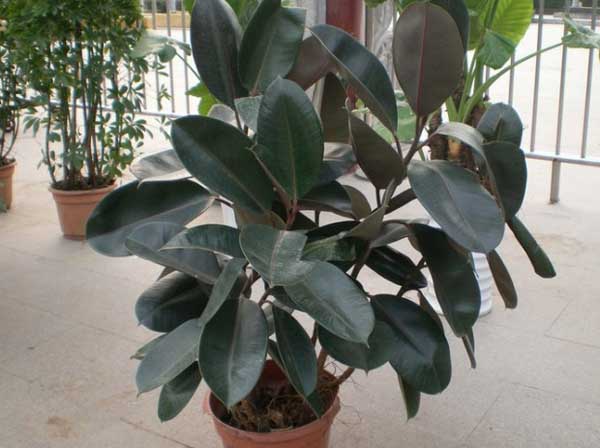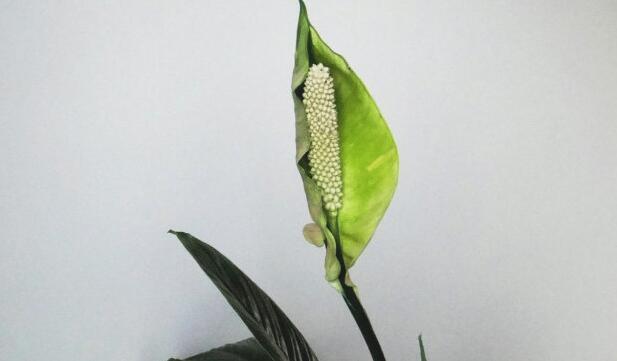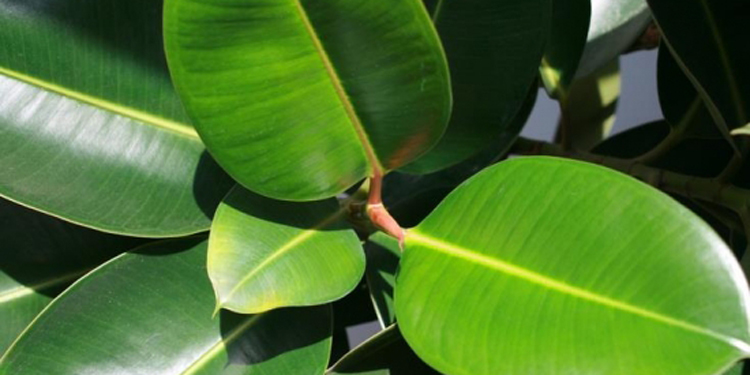What if the lower leaves of the rubber tree turn yellow and fall off?
Rubber tree belongs to perennial evergreen woody plant of Moraceae, its leaves are thick and shiny, evergreen all the year round, some varieties' leaves and tender tips are purplish red, and the plant type is plump and elegant. The common cultivated varieties are:
① black-leaf rubber tree: dark red leaves, red dorsal veins, bright red buds.
② brocade leaf rubber tree: the leaf margin and veins are yellow, self-striped, and the leaves are long oval.
③ rubber tree: the leaves are slightly round, the leaf edges and veins are yellow and white, the young leaves are halo red, and the stipules are red. During the growing period, topdressing was applied once a month, and the basin was changed every 1-2 years. The overwintering temperature should be above 10 ℃.
Rubber trees like warm and humid environment, like sufficient light, shade and drought tolerance, but not cold-resistant, and the suitable temperature for growth is 22-32 ℃. Due to high temperature and drought in summer, low temperature in winter, long-term acceptance of weak light, lack of fertilizer for a long time, application of too thick fertilizer or application of immature fertilizer, etc., the lower leaves of the rubber tree will turn yellow and fall off. the lower part of the older and taller plants are often bald and leafless, affecting the ornamental effect.
The plant can be renewed by cutting off the upper branches and leaves 10-15 cm from the surface of the basin soil when the spring temperature reaches 20-30 ℃, and smearing plant ash on the wound to prevent decay. Given proper temperature, light and fertilizer and water conditions, new buds can sprout under the scissors after 2 to 3 weeks, leaving three strong buds in different directions, and the rest can be wiped out. After a period of careful maintenance, it can grow into robust plants with full branches and leaves. At the same time, the cut branches were cut into 20 cm long stem segments according to the length, and the stem segments were cut into inorganic substrates such as vermiculite and river sand, which were properly shaded and moisturized, and could take root after 30 days. After rooting, they can be planted in flowerpots of appropriate size for normal maintenance and management.
You can also use the high-altitude striping method, that is, in the suitable growing season from June to August, peel off the 1cm wide skin (cortex) in the pressing part, let the white juice flow out, and then according to the conventional method, it can take root after about a month. At the rooting place, cut off the branches and plant them.
What if the rubber tree loses its yellow leaves?

Rubber tree is an evergreen woody foliage plant with large, thick leathery, glossy, round to long oval leaves, dark green leaves and light green backs. It is a very lively plant when placed in the home, but sometimes there are some minor problems, such as the yellowing of the leaves of rubber trees and even the loss of leaves. Today, the editor introduces the causes and solutions of the yellowing and loss of leaves of rubber trees.
Soil consolidation caused by failure to change the basin for a long time
[cause] at the initial stage of rubber tree growth, the basin needs to be changed once a year, and the basin diameter is larger every year. After growing for 6 to 8 years, the basin can be changed every three years. If the basin is not changed for a long time, the basin soil will be seriously hardened and the soil ventilation will be poor. The fibrous root of the rubber tree suffocated and necrosed, unable to absorb water and nutrients, and caused the withered and yellow leaves of the plant.
[solution] when the temperature reaches more than 15 degrees, turn the basin, cut off the dead roots and shake off most of the persistent soil. Remove the yellowed leaves, cut the stem properly, replace the original consolidated basin soil with fresh and fertile culture soil, and often keep the soil moist, which can promote the re-emergence of new roots, restore health, and grow into multi-branched plants. In the future maintenance, it is necessary to keep the basin soil permeable and loosen the basin soil every 15 to 20 days while keeping the basin soil moderately moist, so as to avoid rotting roots or root atrophy caused by repeated watering.
No fertilization for a long time
[cause] Rubber trees like to be fat and flooded. Not applying fertilizer for a long time will lead to malnutrition and yellowing of leaves.
[solution] when changing the basin, an appropriate amount of base fertilizer was added to remove yellow leaves, and then liquid fertilizer was applied every half month, mainly phosphorus and potash fertilizer.
The winter temperature is on the low side.
[cause] the lowest adaptive temperature of rubber tree is more than 6-8 degrees. If the room temperature is less than 5 degrees in winter, the withered and yellow leaves will occur.
[solution] to increase the room temperature through the winter, be sure to keep it above 6-8 degrees.
To water or fertilize too much.
[cause] although the rubber tree is a water-loving and fertilizer-loving plant, if it is watered and fertilized too much, especially from August to September, when the weather is still muggy, too much water is watered and stagnant water is formed in the basin, or too much water is watered during the overwintering period. and the plant is in the dormant period, the transpiration decreases, and the water in the basin can not be discharged in time. Or mistakenly irrigated raw fertilizer, big fertilizer, thick fertilizer, will cause rotting roots due to water and fertilizer damage, resulting in withered and yellow leaves. If the rotten root is caused by fertilizer damage, the root will be accompanied by an unpleasant smell.
[solution] first cut off the rotten root system until the wound section is fresh and white milk exudates. Add a little more to let the wound milk dry, or smear sulfur powder on the wound, or wipe it with clean plant ash and charcoal shavings, and cut off part of the branches at the same time, so as to reduce the transpiration consumption of water, and then plant in a different pot. When replanting, it is appropriate to choose clean and slightly moist fine sand to surround the root wound, and the outside should be planted with fresh and loose sandy soil, strengthen shading and spray management, basin soil is not dry and no longer watering; as long as the plant root system is not too seriously damaged, a new tender fibrous root can be produced at the wound of the root system after a month. After maintenance, often keep the basin soil slightly moist, do not over-watering, can spray water to the leaf surface in the morning and evening.
Lack of moisture
[cause] because the indoor air is too dry, the water in the basin soil is not enough to supply the transpiration of all the leaves, resulting in the yellowing and even shedding of some leaves, especially the old leaves in the lower part.
[solution] check the wetting degree of the basin soil from time to time, replenish water in time, spray water to the leaf surface every morning and evening, and if it is still insufficient, spray water to the leaf surface again around noon. Note: the water temperature of watering and spraying should be basically the same as that of soil greenhouse. If the water temperature of watering and spraying differs greatly from soil temperature and air temperature, it is easy to lead to adverse physiological reactions.
Poor indoor ventilation
[cause] if the room is not ventilated for a long time, some harmful gases, such as high carbon dioxide concentration, will also occur.
[solution] it can be improved by opening windows in time and keeping indoor ventilation and fresh air. In winter, doors and windows can be opened at noon when the temperature is higher to change the indoor air.
Long-term shading
[cause] Rubber tree is a tropical tree species, like plenty of sunshine, not resistant to shade, if you do not see the sun indoors for a long time, there will also be yellow leaves.
[solution] put the plant in a sunlit place.
May have contracted Botrytis cinerea
[cause] Botrytis cinerea is a common and difficult fungal disease in open field and protected crops. it is a disease of low temperature and high humidity. The high incidence period of the disease is when the growth temperature of pathogen is 20: 30 ℃, the temperature is 20: 25 ℃ and the humidity is more than 90%.
[solution] diseased leaves should be picked and burned in time. Increase indoor light and increase room temperature. Or use 50% nonglidine (ethylene sclerotium) wettable powder 1200 times liquid, or 40% chlorothalonil wettable powder 600 times liquid, alternately spraying, 7 to 10 days once, continuous spraying 2 to 3 times, can effectively control the spread of the disease.
How to cultivate and manage rubber trees native to India, Myanmar and other places, India is the most common, so it is also called Indian rubber tree. Because it has white milk and contains rubber, it used to be the main raw material for making rubber before the development of trefoil rubber in Brazil, but later it gave way to trefoil rubber and gradually became an ornamental tree species with hypertrophic and bright leaves. South China and southwest warm areas are mostly planted in the courtyard, while in the Yangtze River valley and north, more potted indoor appreciation, rubber trees like warm, moist, sunny or semi-shady places can grow It is not strict with the soil and has strong adaptability. Multipurpose cuttings. Cut the branches growing in the previous year in spring or cut the new branches in summer, cut and grow 15-20 cm long, keep 1-2 leaves in the upper part of each section, and cut off half of the large leaves and insert them into the soil. When the temperature is above 20 ℃, about 1-2 months can take root and grow into new seedlings. After rooting, the new seedlings can be planted in the pot. at the initial stage, they should be placed in the shade, and after about half a month, they can be moved to a sunny place. Potted plants should pay attention to watering. The transpiration is large in the period of high temperature, sufficient water should be ensured, and watering can be reduced in the rainy season. Fertilization can be combined with watering once a month to irrigate the book fertilizer, do not apply too much nitrogen fertilizer, so as not to grow too prosperous, affecting the ornamental. Should also be moved to a sunny place to receive light, do not place shaded places for too long, otherwise it is easy to lead to leaves yellowing or fallen leaves. Winter overwintering should not be less than lO degrees Celsius. Because of the rapid growth, the basin should be changed every two years at most. When changing the basin, the curled root system should be cut off with a sharp knife, and the branches should be cut short to renew the new shoots. Indoor display also needs regular ventilation to prevent the occurrence of soot disease and shell insects. Seedlings planted in small pots should be moved regularly to prevent oblique growth due to light grabbing and reducing ornamental value. It is better to cultivate rubber trees in the family, but it is inconvenient to put too large plants. Therefore, it should be renewed after two years of growth, combined with changing pots, 3-5 nodes are retained from the base, and the upper part is cut off for re-cutting, and the original plant can grow out after about two months. The new plant will be available in two years. If the house is wide, you can develop a large plant type cultivated in a barrel, but keep the branches low and do not make the branches too high, the lower part will lose its ornamental value.
- Prev

Plain sailing. What are the diseases and insect pests? How to prevent and cure?
(1) disease. The common diseases are bacterial leaf spot, brown spot and blight, as well as root rot and stem rot. There are two ways of infection of bacterial leaf spot. The first type of infection begins on leaves, which is called leaf infection. Leaf infection usually begins at the edge of the leaf and where there are many stomata in the lower part of the leaf. Initial stage
- Next

What if the rubber tree is infected with the disease?
Rubber trees are mainly susceptible to anthracnose and gray spot. Anthracnose mostly occurs on leaves, especially on both sides of leaf veins. The lesion is a round or oval gray spot at first, and then gradually extends to the whole leaf: black particles appear on the spot in the later stage of anthracnose, and pink colloid can be extruded under wet conditions.
Related
- Fuxing push coffee new agricultural production and marketing class: lack of small-scale processing plants
- Jujube rice field leisure farm deep ploughing Yilan for five years to create a space for organic food and play
- Nongyu Farm-A trial of organic papaya for brave women with advanced technology
- Four points for attention in the prevention and control of diseases and insect pests of edible fungi
- How to add nutrient solution to Edible Fungi
- Is there any good way to control edible fungus mites?
- Open Inoculation Technology of Edible Fungi
- Is there any clever way to use fertilizer for edible fungus in winter?
- What agents are used to kill the pathogens of edible fungi in the mushroom shed?
- Rapid drying of Edible Fungi

